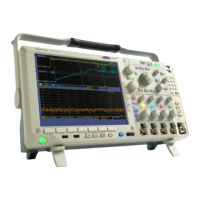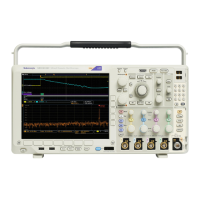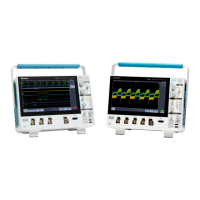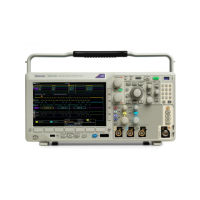Performance Verification
the MDO4000 rea
ding is too low, tighten the preamp more firmly to
the MDO4000 by hand and check the reading again.
4. Check at 5.5 GHz
a. Set the reference level to –25 dBm as follows: Push the front-panel
Ampl button. Push the side-bezel Ref Level button. Set the Ref Level
to –25 dBm.
b. Set the frequency range as follows:
Set the center frequency to 5.5 GHz.
Set the span to 50 MHz.
c. Set the generator to provide a 5.5 GHz, –30 dBm signal.
d. Note the reading on the power meter and the readout for the Reference
marker on the oscilloscope.
e. The absolute difference between the two readings should be small (~ 2dB
or less). If the M DO4000 reading is too low, tighten the preamp more
firmly to the MDO4000 by hand and check the reading again.
f. Check at the –40 dBm reference level.
Set the generator to provide a 5.5 GHz, –45 dBm signal..
Set the reference level to –40 dBm.
Compare the MDO4000 and the power m eter readings as before. The
absolute difference between the readings should be ~2dB or less. If
the MDO4000 reading is too low, tighten the preamp more firmly to
the MDO4000 by hand and check the reading again.
With TPA-N-PRE Attached:
Check Display Average
Noise Level (DANL)
This test does not require an input signal.
The test measures the average internal noise level of the instrument, ignoring
residual spurs.
It checks four ranges:
50kHzto5MHz(allmodels)
5MHzto3GHz(allmodels)
3 GHz to 4 GHz (MDO4104-6 and MDO4054-6 only)
4 GHz to 6 GHz (MDO4104-6 and MDO4054-6 only)
NOTE. If the specific measurement frequency results in measuring a residual spur
that is visible above the noise level, the DANL specification applies not to the
spur but to the noise level on either side of the spur. Please refer to the Spurious
Response specifications. (See page 19.)
110 MDO4000 Series Specifications and Performance Verification

